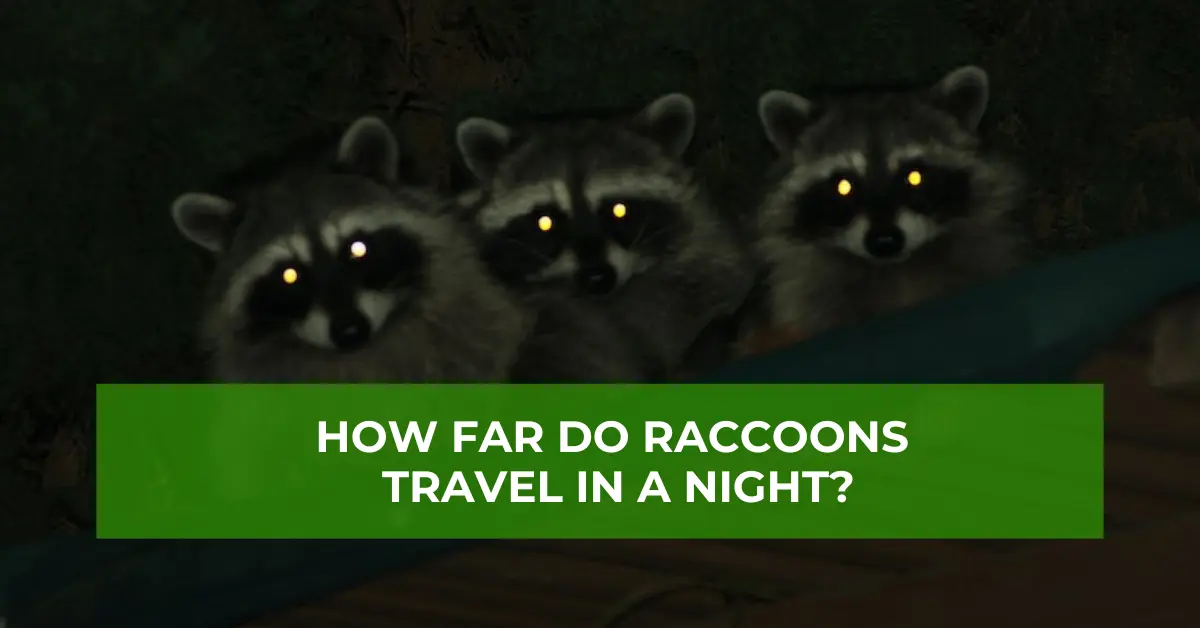How Far Do Raccoons Travel In A Night?

Raccoons can cover up to 20 miles a night. However, it is important to understand that this distance isn’t set in stone. Different factors like weather, terrain, and food availability can all influence how far raccoons travel.
In their quest for food, water, and a comfortable den, raccoons embark on extensive journeys. It’s quite remarkable how far they will roam, especially for male raccoons in rural areas, who may trek up to 10 miles in search of sustenance or a partner.
Once they’ve found a suitable spot to settle down, they mark their territory as a warning to others to keep their distance. A male’s territory can span an impressive 250 acres, while a female’s is usually smaller due to her responsibilities of looking after her young ones and staying close to home.
Research indicates that raccoons in urban areas tend to confine their movements to a smaller range compared to their rural counterparts. This is because cities offer a plethora of resources, such as food, shelter, and potential mates, which they can get within a more concentrated area, reducing the need for long travel.
Urban raccoons demonstrate a remarkable ability to move around their surroundings, even going as far as avoiding major streets to stay clear of hazards.
Do Raccoons Travel During the Day?
Yes, we can say raccoons travel during the day, as well as they travel in the night, but, just how far can raccoons travel in a single day? It’s a bit of a puzzle, as raccoons are creatures known for the night, preferring to be active when it’s dark and catching up on sleep during daylight hours.
Being nocturnal animals, raccoons dedicate their nights to essential tasks for survival. They embark on their search for food after sunset, initially heading to nearby spots where they anticipate finding sustenance.
Often, they will visit rivers, ponds, or small bodies of water like lakes, which offer ample opportunities for meals. However, they’re resourceful creatures and won’t hesitate to scavenge for food in trash cans or explore farms with vegetable patches.
After a night of exploring, raccoons grow weary and retreat to their dens by sunrise to rest for the day ahead. While hunting at night and resting during the day is the typical routine, there can be variations, particularly in unique circumstances such as the arrival of new offspring.
How Far do Raccoons Travel in a Night for Food?
Raccoons are creatures of the night, meaning they are mostly active when it is night. They are incredibly versatile and can cover considerable distances in search of important things like food, water, and shelter.
On an average night, raccoons can travel about 2 to 3 miles, although some have been known to move about for up to 10 miles in a single night. Their nocturnal travels are influenced by various factors, including food availability, the size of their territory, and seasonal changes. During the summer, when resources are more abundant, raccoons might not need to move so far.
However, in the harsher winter months, they may need to trek longer distances to find sustenance. The size of a raccoon’s territory also plays a role in how far they travel. Those living in urban areas tend to have smaller territories due to the ample food and shelter available.
Conversely, raccoons in rural communities may cover larger areas in their search for resources. Additionally, mating and raising young ones can influence their movement, with raccoons travelling less during breeding seasons in spring and fall.
A few important points to note about raccoon travel habits:
- They are good swimmers, capable of traversing significant distances in water.
- Their climbing skills enable them to scale trees and structures for navigation.
- Raccoons possess remarkable intelligence, allowing them to learn about their surroundings and navigate appropriately between food sources.
When observing raccoons travelling long distances, it is crucial to consider their motives. Winter travels may signify a search for sustenance, while spring and fall travel may be related to mating or finding a suitable nesting site. Regardless of the season, long-distance travel may also be driven by the need to run away from predators.
Factors Influencing Raccoon Travel Distances
Raccoons are truly intriguing animals, but their nocturnal activities are not just for aimless wanderings. Various factors influence how far raccoons travel in a night as well as during the day. Let us check together some of those factors:
Season: Raccoons’ travel habits change significantly throughout the year, depending on the seasons.
- Mating Season: During late winter or early spring, which marks the mating season, raccoons tend to travel more deeply in search of potential partners. During this period they cover greater distances as they look out for mates.
- Winter Hibernation: In colder months, raccoons tend to conserve energy by minimizing their movements. While they may still forage for food, their travel distances are generally shorter during winter.
Habitat and Resources: The availability of food and suitable shelter plays a crucial role in determining how raccoons travel and how far they can go.
- Abundant Food Sources: Raccoons are opportunistic eaters, and if they find an area with plenty of food, such as accessible trash cans or natural food sources, they’re less likely to travel far.
- Shelter and Nesting Sites: Access to safe shelter and nesting spots also affects how far raccoons travel. Raccoons know how to make dens in tree hollows, burrows, or even human structures like attics. If they find suitable shelter nearby, they may not need to travel as much.
Age and Gender: Age and gender are additional factors influencing raccoon travel habits.
- Young Raccoons: Young raccoons, or kits, usually travel shorter distances as they’re more vulnerable and less experienced. They tend to stick closer to their den until they mature.
- Female Raccoons: Female raccoons, especially those with babies (kits), have shorter travel distances as they prioritize caring for their young. This maternal instinct keeps them near their den sites.
- Male Raccoons: Adult male raccoons typically travel farther, especially during mating season when they’re actively looking for female raccoons. Their night journeys can span several miles.
Understanding these factors offers valuable insights into raccoon behaviour, shedding light on not just how far raccoons travel, but also why and when they embark on their nocturnal adventures.




